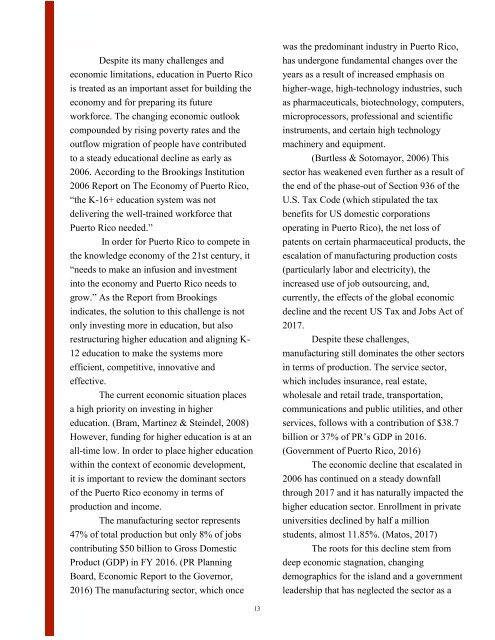CLC-Conference-Proceeding-2018
You also want an ePaper? Increase the reach of your titles
YUMPU automatically turns print PDFs into web optimized ePapers that Google loves.
Despite its many challenges and<br />
economic limitations, education in Puerto Rico<br />
is treated as an important asset for building the<br />
economy and for preparing its future<br />
workforce. The changing economic outlook<br />
compounded by rising poverty rates and the<br />
outflow migration of people have contributed<br />
to a steady educational decline as early as<br />
2006. According to the Brookings Institution<br />
2006 Report on The Economy of Puerto Rico,<br />
“the K-16+ education system was not<br />
delivering the well-trained workforce that<br />
Puerto Rico needed.”<br />
In order for Puerto Rico to compete in<br />
the knowledge economy of the 21st century, it<br />
“needs to make an infusion and investment<br />
into the economy and Puerto Rico needs to<br />
grow.” As the Report from Brookings<br />
indicates, the solution to this challenge is not<br />
only investing more in education, but also<br />
restructuring higher education and aligning K-<br />
12 education to make the systems more<br />
efficient, competitive, innovative and<br />
effective.<br />
The current economic situation places<br />
a high priority on investing in higher<br />
education. (Bram, Martinez & Steindel, 2008)<br />
However, funding for higher education is at an<br />
all-time low. In order to place higher education<br />
within the context of economic development,<br />
it is important to review the dominant sectors<br />
of the Puerto Rico economy in terms of<br />
production and income.<br />
The manufacturing sector represents<br />
47% of total production but only 8% of jobs<br />
contributing $50 billion to Gross Domestic<br />
Product (GDP) in FY 2016. (PR Planning<br />
Board, Economic Report to the Governor,<br />
2016) The manufacturing sector, which once<br />
was the predominant industry in Puerto Rico,<br />
has undergone fundamental changes over the<br />
years as a result of increased emphasis on<br />
higher-wage, high-technology industries, such<br />
as pharmaceuticals, biotechnology, computers,<br />
microprocessors, professional and scientific<br />
instruments, and certain high technology<br />
machinery and equipment.<br />
(Burtless & Sotomayor, 2006) This<br />
sector has weakened even further as a result of<br />
the end of the phase-out of Section 936 of the<br />
U.S. Tax Code (which stipulated the tax<br />
benefits for US domestic corporations<br />
operating in Puerto Rico), the net loss of<br />
patents on certain pharmaceutical products, the<br />
escalation of manufacturing production costs<br />
(particularly labor and electricity), the<br />
increased use of job outsourcing, and,<br />
currently, the effects of the global economic<br />
decline and the recent US Tax and Jobs Act of<br />
2017.<br />
Despite these challenges,<br />
manufacturing still dominates the other sectors<br />
in terms of production. The service sector,<br />
which includes insurance, real estate,<br />
wholesale and retail trade, transportation,<br />
communications and public utilities, and other<br />
services, follows with a contribution of $38.7<br />
billion or 37% of PR’s GDP in 2016.<br />
(Government of Puerto Rico, 2016)<br />
The economic decline that escalated in<br />
2006 has continued on a steady downfall<br />
through 2017 and it has naturally impacted the<br />
higher education sector. Enrollment in private<br />
universities declined by half a million<br />
students, almost 11.85%. (Matos, 2017)<br />
The roots for this decline stem from<br />
deep economic stagnation, changing<br />
demographics for the island and a government<br />
leadership that has neglected the sector as a



